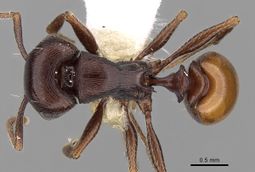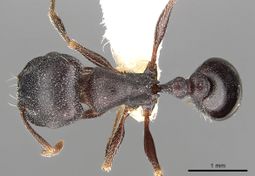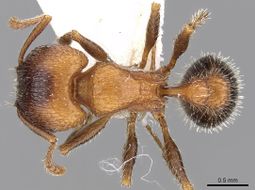Key to Afrotropical Tetramorium solidum species group
This worker key is based on Mbayana et al (2018)[1], with the addition of Tetramorium nama described by Hawkes (2020) [2]
You may also be interested in:
- Tetramorium
- Afrotropical Tetramorium species groups
- Key to Afrotropical Tetramorium species groups
- Tetramorium solidum species group diagnosis
1
- Body with branched pilosity (Fig. 2C) => Tetramorium rothschildi
- Body either lacking pilosity or with simple pilosity (Fig. 2A–B, D–I) => 2
2
return to couplet #1
- Dorsum of mesosoma in profile without any erect hairs, with appressed pubescence only (Fig. 2D–H) => 3
- Dorsum of mesosoma in profile with erect hairs (Fig. 2A–B, I) => 14
3
return to couplet #2
- Body with short, broad, blunt, much flattened and strongly appressed glittering silvery hairs (Fig. 2D–F) => 4
- Body without such hairs, only with sparse simple appressed pubescence (Fig. 2G–H) => 6
4
return to couplet #3
- Appressed pubescence long, dense and strap-like, hairs often overhanging one another (Fig. 2E) => Tetramorium galoasanum
- Appressed pubescence sparse and spaced out, not strap-like and not overlapping (Fig. 2D–E) => 5
5
return to couplet #4
- The base of the first gastral tergite in profile forming a thick, laterally projecting downcurved flange, which obscures the tergosternal suture basally and base of the sternite; reddishbrown or red species (Fig. 3A) => Tetramorium setuliferum
- The base of the first gasteral tergite in profile not projecting as above, the tergosternal suture and base of the sternite clearly visible; blackish brown to black species (Fig. 3B) => Tetramorium clunum
6
return to couplet #3
- In dorsal view both waist segments much broader than long and transverse, especially postpetiole extremely broadened with very well developed alar extensions making it approximately as broad as pronotum (Fig. 3C) => Tetramorium grandinode
- Waist segments, especially the postpetiole never shaped as above; if postpetiole with small alar extensions, then petiole not broadened (Fig. 3D–F) => 7
7
return to couplet #6
- Propodeum unarmed, lacking propodeal spines (Fig. 3G) => Tetramorium jordani
- Propodeum armed with a pair of spines (Fig. 3H–I) => 8
8
return to couplet #7
- Petiole node distinctly broader than long (DPeI 145–165) => 8a
- Petiole node usually broader than long, but not distinctly so, sometimes slightly longer than broad (DPeI 90–135) => 9
8a
return to couplet #8
- Mesosoma and petiole dorsally finely reticulate, postpetiole dorsum smooth to finely reticulate, with scattered piligerous foveolae, postpetiole narrower (DPpI 162–179) => Tetramorium lerouxi
- Mesosoma dorsum longitudinally costulate, petiole dorsum with roughly concentric to irregularly transverse costulae, postpetiole transversely costulate, postpetiole broader (DPpI 184–201) => Tetramorium nama
9
return to couplet #8
- In full-face view head narrower in front of eyes than behind eyes (Fig. 3J) => Tetramorium barbigerum
- In full-face view head broader in front of eyes than behind the eyes, or same width (Fig. 3K–M) => 10
10
return to couplet #9
- In profile posterodorsal corner of petiolar node sharply angled and slightly projecting posteriorly (Fig. 3N) => Tetramorium duncani
- In profile posterodorsal corner of petiolar node rounded or rectangular but not sharply angled as above (Fig. 3O–P) => 11
11
return to couplet #10
- Head broader in front of eyes than behind eyes (Fig. 3K) => Tetramorium pogonion
- Head same width in front of eyes as behind eyes (Fig. 3L–M) => 12
12
return to couplet #11
- Dorsum of mesosoma completely longitudinally or irregularly rugulose/rugose (Fig. 4A) => Tetramorium signatum
- Dorsum of mesosoma either predominantly shiny with only superficial punctate sculpture, or densely reticulate punctate, often with few faint longitudinal costulae, median area of mesosoma usually very weakly sculptured (Fig. 4B) => 13
13
return to couplet #12
- Propodeal spines short, broad and acute apically (PSLI 4–8) (Fig. 3H) => Tetramorium glabratum
- Propodeal spines long and narrow (PSLI 16–23) (Fig. 3I) => Tetramorium rufescens
14
return to couplet #13
- Abundant erect hairs on all dorsal surfaces of head and body (Fig. 2D–E) => 15
- Only one to four pairs of hairs present on dorsum of mesosoma (Fig. 2L) => 18
15
return to couplet #14
- Antennal scapes with erect hairs (Fig. 4C) => 16
- Antennal scapes without erect hairs, only with flattened pubescence (Fig. 4D) => 17
16
return to couplet #15
- Dorsal surface of mesosoma with strongly developed irregular reticulate sculpture; colour orange (Fig. 4E, G) => Tetramorium peringueyi
- Dorsal surface of mesosoma with short longitudinal rugulae; ground sculpture mainly smooth and shiny with peripheral patches of fine, superficial reticulations; colour uniformly black (Fig. 4F, H) => Tetramorium margueriteae
17
return to couplet #16
- Propodeum armed with acute spines (PSLI 10–16); colour light brown, with gaster a little bit darker compared to mesosoma (Fig. 4I) => Tetramorium dichroum
- Propodeum with short propodeal teeth (PSLI 6); colour reddish brown, with gaster black (Fig. 4J) => Tetramorium brigitteae
18
return to couplet #14
- Propodeum with elongate and acute spines (PSLI 17–21) (Fig. 4K) => Tetramorium solidum
- Propodeum with short triangular teeth (PSLI 5–9) (Fig. 4L) => Tetramorium aisha
References
- ↑ *Mbanyana N., Hita Garcia F., Robertson H.G. & Le Roux J.J. 2018. A taxonomic revision of seed harvester ants of the Tetramorium solidum group (Hymenoptera: Formicidae) in southern Africa. European Journal of Taxonomy 454: 1–59. https://doi.org/10.5852/ejt.2018.454
- ↑ Hawkes PG (2020) A new species in the Tetramorium solidum-group (Hymenoptera, Formicidae, Myrmicinae) from the Richtersveld National Park, South Africa, with an assessment of threats and conservation status. ZooKeys 965: 55–71. https://doi.org/10.3897/zookeys.965.52735




















































